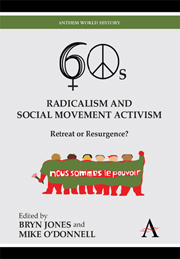Book contents
- Frontmatter
- Contents
- Introduction Sixties Radicalism: Creating Spaces and Leaving Legacies
- PART I Radical Movements Around the World
- PART II Theoretical & Cultural Significance
- 6 Nineteen Sixties Radicalism in the United States: Its Rise, Decline and Legacy
- 7 Students, Artists and the ICA: The Revolution Within
- 8 The Situationist Legacy: Revolution as Celebration
- 9 Habermas on Sixties Student Protests: Reflections on Collective Action and Communicative Potential
- PART III Social Movement Legacies
- Conclusion
- Notes on Contributors
- Author Index
- Subject Index
7 - Students, Artists and the ICA: The Revolution Within
from PART II - Theoretical & Cultural Significance
Published online by Cambridge University Press: 05 March 2012
- Frontmatter
- Contents
- Introduction Sixties Radicalism: Creating Spaces and Leaving Legacies
- PART I Radical Movements Around the World
- PART II Theoretical & Cultural Significance
- 6 Nineteen Sixties Radicalism in the United States: Its Rise, Decline and Legacy
- 7 Students, Artists and the ICA: The Revolution Within
- 8 The Situationist Legacy: Revolution as Celebration
- 9 Habermas on Sixties Student Protests: Reflections on Collective Action and Communicative Potential
- PART III Social Movement Legacies
- Conclusion
- Notes on Contributors
- Author Index
- Subject Index
Summary
1968: Writing and Event
As the highpoint of sixties radicalism, 1968 was a year of action. This was certainly true for London's Institute of Contemporary Arts which moved that year from its small premises in Dover Street to its current grander location on the Mall. However, Roland Barthes comments that, ‘every national shock produces a sudden flowering of written commentary’ (1968, 149) and 1968 was also a year of prolific written documentation. The immediacy of 1968's historicization not only reveals its importance, but also its compromises and failures, as writers struggled to make sense of its disparate aims and ideological absences. America may have had some of the most famous chroniclers of that generation in the form of Susan Sontag, Norman Mailer and Paul Goodman (Sayres 1984, 217–219), but the UK also had its own acute observers such as Jeff Nuttall (1968), Australian born Richard Neville (1971) and Michael Kustow (1975). The confusion and frustration, as well as excitement, felt in these writers' voices may well have been a consequence of the newness of many of the movements that comprised the late 1960s.
Sayres sees Norman Mailer's alienation as stemming from his being left outside by ‘women writers, blacks, gays, third world authors [who] presumed to speak for themselves about struggles he was barely privy to’ (Sayres 1984, 218–219). However, in Britain in 1968, these movements were very much still emergent (although, far from non-existent, as attested by the activities of Anti- University (Elzy 1969) and Birmingham's Centre for Cultural Studies under the new direction of Stuart Hall).
- Type
- Chapter
- Information
- Sixties Radicalism and Social Movement ActivismRetreat or Resurgence?, pp. 111 - 132Publisher: Anthem PressPrint publication year: 2010
- 1
- Cited by



